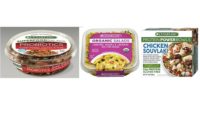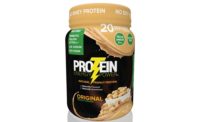PROTEIN Power

Protein is "in."Carbs are out. This new high-protein fashion era is driven by a proliferation of high-protein popular literature, and perhaps by demand from the burgeoning number of carbohydrate-sensitive people with diabetes. Protein is indispensable to life. And, in today's market, it dictates food selection, menu planning and, ultimately, product development.
So how big is protein, and where is it exerting its influence? Querying Mintel International's (Chicago) Global New Products Database (GNPD), with the tag "high protein" during 2001-2003, yields a surprisingly low number of new launches or reformulations, given the hype. However, change the search to "low-carb," and the magic unfolds. "Carb" is the clincher; "protein" is the power. (But caution, low-carb products do not necessarily mean that the product contains high levels of protein.) The GNPD reports 151 new low-carb products introduced globally from January to December 2003, of which 148 were introduced in North America. Compare this to 2002 figures, where a mere 40 new low-carb products were reported in North America using this tag.
In the pure "high-protein"? category, energy and meal replacement bars claimed 45% of new North American product introductions in 2003. Despite the dominance of snack products, other interesting niche products came to market. Keto Foods and Snacks (Neptune, N.J.), launched Keto Ketato Classic Potato Flavored Gourmet Mix for diabetics. Designed for "low-carb/high-protein living," the product provides "creamy-smooth mashed potatoes without the carbs."
In the bakery category, Bakery Barn (Baldwinboro, Pa.) introduced microwavable or oven-baked Soft-Batch Lean Protein Cookies, containing a "proprietary protein blend" (cross-flow microfiltered whey protein concentrate, whey isolate, soy isolate, nonfat milk concentrate, powdered whole egg). Herbalife of Canada (Calgary, Alberta) launched Thermojetics Ultimate High-Protein Low-Carb (weight control) Program, which provides a tracking system to accompany the program combination of shakes, soups, supplements and bars. And not forgetting a popular source of protein, Eberly Poultry Farms (Stevens, Pa.) introduced Certified Organic Chicken "from carefully selected chickens that are fed a vegetarian diet of high-protein, organic grains."

Soy Versus Whey
Dominant proteins in food products, soy and whey are jostling for position in food, science and health communities. Querying soy and whey "protein"? and "isolates"? across global and North American markets (2001-2003) declares soy the winner. However, whey is receiving increasing attention from health and consumer communities. Spokespersons from the whey camp point to soy's low-cholesterol health claim as a driver for ingredient inclusion and consumer purchases. Recent clinical trials indicating a possible role for whey protein in blood pressure modification may be a boost to whey protein market share, should an associated health claim emerge. Since 2001, 83 new North American products containing soy protein and associated low-cholesterol positioning were reported in Mintel's GNPD.
Getting to the Nitty Gritty
In the March 2003 article addressing trends in ingredient use, this magazine discussed the inclusion of "purer, specialty ingredients"? in products. Protein fractionates are no stranger to this trend, which only will continue to grow as science validates more uses for protein derivatives. Once again, whey and soy feature strongly in the fractionate discussion. Querying GNPD for "amino acids, peptides, isolates"? yielded 18 reported new products/extensions for 2003 in North America, of which 12 were in the snack category.
IncaMaize (Toronto, Ont.) launched Inca Gold Original Tortilla Chips, "made with an organic Hi-Lysine corn that contains nine essential amino acids."? According to the company, Hi-Lysine Corn has 90% of the biological value of milk protein when compared with ordinary corn, which has 40%.
Other snack category products were positioned for weight control, meal replacement and energy. Health From the Sun (Sunapee, N.H.) introduced Competitor's Edge-hfs--Low Carb Weight Loss for Women meal replacement. This product has a "modified protein to carbohydrate ratio of 30:8," designed for female athletes. It also contains a "potent thermogenic green tea extract, an essential and non-essential fatty acid complex, lignan-rich organic flaxseed powder, and a combination of isoflavone-enriched soy and whey protein isolates."
American Body Building Products' (Fremont, Ohio) ABB Extreme XXL shows that weight control does not mean weight loss. This "powdered weight gain supplement" contains a full complement of micronutrients and 410mg each of L-glutamine and glutamine peptides. Glutamine plays a preventive role in muscle mass retention during physiological stress (exercise/illness). It is a popular inclusion in products targeted to athletic communities. The GNPD showed 40 new food/supplement products in North America specifically listing a glutamine ingredient in 2003.
Myoplex Deluxe Dietary Supplement Bars from EAS (Golden, Col.) "have an optimal nutrition formula that contains 25g of protein and 2g of glutamine and glutamine peptides." Dr. Bob Martin's ImmuAll, an "age-defying"? dietary supplement from Natural Care (Orem, Utah) contains a "combination of some of the most powerful nutraceutical immune modulators available" and includes 100mg of L-glutamine. NOW Foods (Bloomingdale, Ill.) has Strawberry Whey Protein Supplement Powder containing 26g of protein per serving and "fortified with glutamine powder."
Some products appear to serve multiple functions. Protein derivatives are popular inclusions in these "all-rounder"? products because, like the product, they serve a diversity of needs. Case in point: PowerBar Energy Bite from Powerfood (Nestle USA--Glendale, Calif.). These bars contain soy protein, "a complete protein, providing all of the essential amino acids in the proportions required by the human body. Amino acids aid in repair, growth, and development of muscle."?
The product also contains branched chain amino acids (leucine, valine and isoleucine) and delivers "vitamins and minerals vital for aiding energy metabolism." Life Time Fitness' (Eden Prairie, Minn.) Fast Fuel Chocolate Crunch Energy Bar is made with an "increased energy formula to maximize energy, stamina and muscle recovery." This includes 12g of protein and "balanced nutrients to control appetite." ? And some bars are generally good for both function and technology. BioNutritional Research (Santa Ana Heights, Calif.) Power Crunch is touted as a high-energy snack which is low-fat, low-carb and a mere 185 calories. The product "combines advanced protein and fiber technology" and includes a protein blend listed as [proto whey (micro peptides from extreme hydrolyzed whey protein fraction, maltodextrin, L-glutamine, softpsil (micronized psyllium fiber), MCTs (medium chain triglycerides), sucralose), milk protein isolate].
Sidebar 1:
Going Global
A question that surfaced during the 2003 New Products Conference was whether the low-carb trend is here to stay. The answer is yes, but not everywhere. If you match low-carb to high-protein formulations, what is seen globally? According to the GNPD, only three products tagged as low-carb were released outside of North America in 2003, but 49 products were marketed with "high-protein"? positioning.
Tropical Canning of Thailand introduced its Chicken Spread with Crackers, "a high-quality and high-protein snack kit."? Nature's Best, Belgium, launched Easy Body Protein Hot Chocolate with Vitamins. Yeo Hiap Seng, Malaysia, introduced High Protein Soy Milk, "scientifically formulated with a unique ratio (1:5) of omega-3 & -6 for optimum effect." The product is "formulated to U.S. FDA recommendations."
Looking specifically at protein derivatives, Kyodo Milk Industry in Japan launched Amino 7 Yogurt, a "functional product"? containing alginine, leucine, valine, isoleucine, lysine, glutamine and tryptophan. In South Korea, Namyang Dairy Products released Imperial Dream XO Baby Food. "Patterned after breast milk," it contains "high-quality, certified organic fats, carbohydrates, proteins and various essential vitamins and minerals that healthy babies need during their growing from six months to a year old." Ingredients include protein derivatives--milk, whey powder, whey protein concentrate, casein phosphopeptides, hydrolyzed whey protein concentrate, nucleotide (CMP, AMP, UMP-2Na, GMP-2Na, IMP-2Na), casein hydrolysate, milk fat globule membrane protein, a-lactalbumin, casein phosphopeptides and glycomacropeptide. Maeil Dairy in South Korea also introduced Absolute Masterpiece Baby Food containing lactoferrin, taurin, L-carnitine and L-arginine.
Links
Looking for a reprint of this article?
From high-res PDFs to custom plaques, order your copy today!






